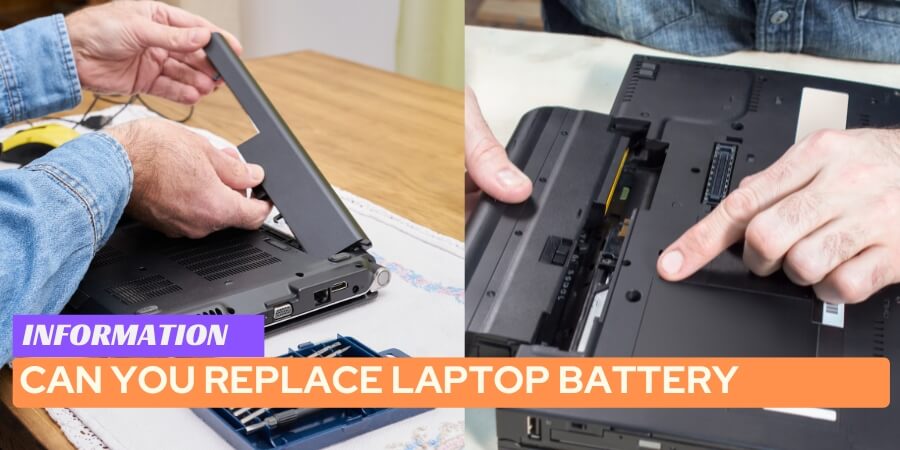Are you experiencing a shorter battery life on your laptop? Is your laptop battery not holding its charge like it used to? It’s common for laptop batteries to wear out over time, but the good news is that they can be replaced.
Many people assume that replacing a laptop battery requires professional help or is too complicated to do on their own, but that’s not the case.
With the right tools and a little guidance, replacing your laptop battery is a quick and straightforward process that you can easily handle yourself.
In this article, I will provide you with a comprehensive guide to help you replace your laptop battery, including some nifty tips to make the process even smoother.
So, let’s dive in and learn how to replace your laptop battery!
Table of Contents
Key Takeaways:
- You can replace your laptop battery yourself with the right tools and guidance
- Replacing your laptop battery is a quick and straightforward process
- Laptop batteries wear out over time and need to be replaced
- A laptop battery replacement can enhance your laptop’s performance and increase its lifespan
- Always consult your laptop’s user manual for specific instructions and safety guidelines
How to Replace Laptop Battery
Replacing your laptop battery is a daunting task. Still, with the right tools and guidance, it can be done easily and efficiently.
Here, I’ll take you through the step-by-step process of how to replace your laptop battery.
Whether you’re a seasoned DIY-er or a novice, this tutorial will provide you with the knowledge you need to successfully replace your laptop battery.
1. Gather your tools
Before you begin, it’s essential to have all the necessary tools on hand.
Here’s what you’ll need:
- Screwdriver (check your laptop manual for the type)
- New laptop battery
- Anti-static wrist strap (optional but recommended)
Make sure to purchase a battery that is compatible with your specific laptop model. Consult your laptop manual or online resources for help identifying the correct battery.
2. Shut down your laptop and unplug it
Before handling any components of your laptop, it’s crucial that you turn it off and unplug it from any power source.
This will prevent any potential electrical hazards and ensure the safe handling of your device.
3. Locate the battery compartment
Depending on your laptop model, the battery compartment may be located on the bottom or side of your device.
Consult your laptop manual or online resources for help identifying the location of the battery compartment.
4. Remove the old battery
Once you’ve located the battery compartment, use a screwdriver to remove the screws holding the compartment cover in place.
Carefully remove the cover and locate the battery. Gently unclip the battery from its connectors and carefully remove it from the compartment.
5. Install the new battery
Take your new battery and gently clip it onto the connectors in the battery compartment. Carefully place the cover back onto the compartment and tighten the screws to secure it in place.
6. Power on your laptop
Once you’ve installed the new battery, power on your laptop and check that it’s working properly.
Your laptop may take a few minutes to recognize the new battery and adjust its settings accordingly.
7. Dispose of the old battery properly
It’s essential to dispose of your old laptop battery properly. Check with your local recycling center or electronic waste disposal facility for guidelines on how to dispose of electronic waste in your area.
That’s it! Following these simple steps will allow you to replace your laptop battery easily and efficiently.
By doing it yourself, you’ll save money and ensure that your laptop’s battery works optimally for years to come.
Laptop Battery Installation Guide
Now that you have your new laptop battery, it’s time to install it. Don’t worry; the process is straightforward and easy to follow.
Before starting, ensure that you have turned off your laptop and disconnected it from the power source.
1. Step-by-Step Guide to Install Laptop Battery:
- Remove the Old Battery: Locate the battery release latch on the bottom of your laptop, slide it over, and hold it in place. Then, slide the battery out of its compartment.
- Prepare the New Battery: Remove the new battery from its packaging and check that it is the correct model and compatible with your laptop.
- Align and Insert the New Battery: With the battery release latch still in the open position, align the new battery so that the metal contacts face the contacts in the battery compartment. Then, gently push the battery into place.
- Secure the New Battery: Once the battery is in place, gently push it towards the laptop until you hear a click, indicating that the battery is securely locked in place.
- Test the New Battery: Turn on your laptop and check that the battery is functioning correctly. If there are any issues, shut down the laptop and retrace the installation steps to ensure there are no mistakes.
It’s essential to consult your laptop manual before beginning the installation process, as different models may have unique requirements.
If you don’t feel comfortable installing the new battery yourself, you can take it to a professional technician who can help.
2. Laptop Battery Removal Tips
Before removing your old laptop battery, it’s important to take some precautions to ensure your safety.
First, shut down your laptop and unplug it from any power source. Make sure you are working in a clean, dry area with plenty of space to move around.
Next, locate the battery compartment on your laptop. It’s usually located on the bottom of the laptop or behind a cover on the side.
Consult your laptop’s user manual for specific instructions on accessing the battery compartment.
Once you have access to the battery compartment, carefully remove the battery by gently pulling on the latch or using a screwdriver to release any locking mechanisms.
Be sure to handle the battery carefully, as it may still contain some charge and can be potentially hazardous.
Tip: If you have trouble removing the battery, try wiggling it back and forth or applying gentle pressure to loosen it from its position.
Just be careful not to damage any of the surrounding components.
If you’re upgrading your laptop battery, make sure the new battery is compatible with your laptop model. Check the specifications of both the old and new batteries to ensure they match up.
Installing an incompatible battery can cause damage to your laptop and potentially create a safety hazard.
Once you have removed the old battery, dispose of it properly. Please do not throw it in the trash or attempt to incinerate it.
Many electronic stores offer recycling programs for laptop batteries, or you can contact your local waste management center for guidance on proper disposal methods.
Now that you’ve successfully removed your old battery, you’re ready to install your new one. Refer to our guide in section 2 for step-by-step instructions on how to complete the process.
Laptop Battery Lifespan and Compatibility
When it comes to laptop batteries, it’s important to understand their lifespan and compatibility with your laptop.
The lifespan of a laptop battery is typically 2-4 years, depending on usage and care. Over time, the battery’s capacity to hold a charge will decrease, resulting in shorter usage time between charges.
In terms of compatibility, not all laptop batteries are created equal. It’s important to ensure that the replacement battery you choose is compatible with your laptop model.
The best way to ensure compatibility is to purchase a battery directly from the laptop manufacturer or a reputable third-party seller.
| Laptop Brand | Average Lifespan | Compatible Battery Models |
|---|---|---|
| HP | 2-4 years | HP VI04, HP VI06, HP 807956-001 |
| Dell | 2-3 years | Dell 4K8YH, Dell V8VNT, Dell N2DN5 |
| Lenovo | 3-5 years | Lenovo L12L4A02, Lenovo L12M4E01, Lenovo L12S4E01 |
As you can see from the table above, the lifespan and compatible battery models can vary between laptop brands.
It’s important to do your research and choose a battery that is specifically designed for your laptop model.
Overall, understanding the lifespan and compatibility of your laptop battery is crucial when it comes to replacing it.
By choosing a compatible battery and properly caring for it, you can extend the life of your laptop and ensure consistent and reliable usage time.
Essential Tools for Laptop Battery Replacement
Before you begin replacing your laptop battery, it’s crucial to have the right tools.
Here are some essential tools you’ll need:
| Tool | Description |
|---|---|
| Screwdriver | You’ll need a screwdriver to remove the back panel of your laptop and access the battery |
| New battery | Make sure to purchase a new battery that is compatible with your laptop model |
| Anti-static wrist strap | This will protect your laptop from any static electricity that could damage its components |
It’s important to note that some laptops may require additional tools or specific parts for battery replacement.
Always consult your laptop’s user manual to ensure you have everything you need before beginning the replacement process.
Once you have all the necessary tools, you can begin the process of replacing your laptop battery.
Follow our guide in section 2 for step-by-step instructions, and refer back to this table to ensure you have all the essential tools.
Laptop Battery Troubleshooting
Replacing your laptop battery is a simple task, but sometimes, issues can arise that require troubleshooting.
Here are a few common problems you may encounter and how to solve them:
1. Battery not charging
If your laptop battery is not charging, try the following:
- Check that the charging cable is correctly connected to both the laptop and the power source.
- Make sure the outlet you’re using is working by plugging in another device.
- Unplug the laptop and remove the battery, then press and hold the power button for 30 seconds. Reconnect the battery and try charging again.
- Try using a different charging cable or adapter to see if the issue is with the equipment.
2. Battery not holding charge
If your battery is not holding a charge, try the following:
- Make sure that the battery is installed correctly and connected.
- Check that the battery contacts are clean and free of any debris.
- Run a battery diagnostic to see if the battery needs to be replaced.
3. Overheating
If your laptop is overheating after replacing the battery, try the following:
- Ensure that the battery is compatible with your laptop model and meets the manufacturer’s specifications.
- Clean the laptop’s cooling fan and air vents to ensure proper airflow.
- Lower the screen brightness and close any unnecessary programs or applications.
If you encounter any other issues while troubleshooting your laptop battery, consult the manufacturer’s user manual or seek assistance from a professional technician.
Conclusion on Can You Replace Laptop Battery
In conclusion, replacing your laptop battery is a task that you can easily do yourself. It doesn’t require any specialized training or experience.
By following our comprehensive guide and helpful tips, you’ll be able to replace your laptop battery effortlessly.
Remember that replacing the battery is not the only way to improve your laptop’s performance.
There are other ways to optimize your laptop’s battery life, such as adjusting the power settings and decreasing the brightness of your display screen.
However, if you’ve decided that you need to replace your laptop battery, make sure to consult your laptop’s user manual for specific instructions and safety guidelines.
Safety should always be your top priority.
Don’t let the thought of laptop battery replacement intimidate you. With our guide and tips, you have all the tools you need to replace your battery yourself and enjoy extended usage time. Don’t hesitate to give it a try!
Replacing Your Laptop Battery Has Never Been Easier
By replacing your laptop battery yourself, you’ll save time and money. You can order a new battery online or purchase one from your local electronics store.
Then follow our guide, and you’ll replace your battery in no time.
Thank you for reading our guide on laptop battery replacement. We hope it was informative and helpful to you. Don’t forget to share this guide with others who may benefit from it.






